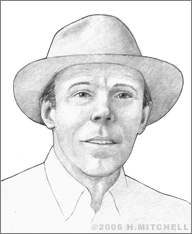Gunther Von Hagens
Physician and inventor Gunther von Hagens created a remarkable technique for preserving human tissue after death. The technique, known as plastination, has been introduced worldwide through his “Body Worlds” public exhibitions, where people of all ages have been able to view the internal organs and muscles of the human body in spectacularly presented and pristine form.
Born Gunther Gerhard Liebchen in 1945 in the town of Alt-Skalden, Poland, which was then part of Germany, von Hagens’ parents left the area with their infant son when Russian occupation threatened. They moved first to Berlin, then, settled in Greiz, Germany, where von Hagens spent much of his childhood and his teenage years. He suffered a rare bleeding disorder as a child and spent a great deal of time around doctors and hospitals; the disease limited him from participating in some childhood activities but it also helped to foster in him an early interest in science in medicine.
When he was 19, von Hagens entered medical school at Germany’s University of Jena. He also became enlightened as to alternative governments and civilizations and began to question Communism and Socialism. He became a student activist and eventually planned to escape into Austria in 1969 by crossing the Czechoslovakian border. He was detained, missed an opportunity to escape, was arrested and extradited to East Germany where he spent nearly two years in prison and was forced into rehabilitation. West Germany paid $20,000 for his release, however, and in 1970, he continued his medical studies at the University of Lubeck, from where he graduated in 1973.
After completing his residency in Heligoland, von Hagens joined Heidelberg University’s Department of Anaesthesiology and Emergency Medicine. He later became a resident and lecturer at the university’s Institute of Pathology and Institute of Anatomy. He married a former classmate, Dr. Cornelia von Hagens, in 1975, and adopted her last name. (In 1992, he married physician Angelina Whalley.)
In 1977, von Hagens conceived of the idea of plastination when he was looking at a collection of specimens preserved in plastic. At that time, it was common for tissue preserved for medical study to be embedded deep inside a clear plastic block. He thought it would make more sense to push the plastic directly into the tissue cells and stabilize them from within, which would make the specimens rigid and allow researchers to actually hold them in their normal forms.
He began experimenting, and spent six years refining his plastination technique. He patented it between 1978 and 1982, and formed a company, Biodur Products, in 1978 to distribute the necessary equipment and materials for those interested in using the plastination process themselves.
The process works by first halting decomposition of human tissue after death. This is achieved by embalming the body and dissecting it, removing each specimen and extracting all bodily fluids and soluble fats. These substances are then replaced with reactive resins and elastomers. The specimens are then posed as desired for teaching or display purposes, and cured. The finished product is rigid and stable. According to von Hagens, however, the specimens also retain their surface structure and remain identical in cellular structure to how they were before preservation, which makes even microscopic study possible.
Von Hagens originally designed plastination for use in the medical field, but in 1995, he introduced plastination to the masses with his first Body Worlds exhibition in Tokyo, Japan. The exhibition was met with a great deal of controversy as religious organizations opposed his use of deceased humans’ body parts as so-called “art.” He contends, however, that the shows are meant to enlighten and educate. More than 20 million have viewed his work via Body Worlds shows in 30 cities across Asia, Europe and North America, where skinless, preserved human bodies are posed in a variety of scenes allowing viewers to look at healthy and diseased organs, bones, muscles and nerves in a unique and fascinating way. All specimens come from donors who consent to the use of their bodies for the purpose in writing prior to death.
Von Hagens founded the Institute for Plastination in Heidelberg in 1993, which offers plastinated specimens for the Body Worlds shows as well as for educational use. More than 400 institutions in 40 countries worldwide use plastination for medical instruction. Von Hagens left the University of Heidelberg in 1996 to accept a visiting professorship at Dalian Medical University in China; that year he was also named director of the plastination research center at the State Medical Academy in Bishkek/Kyrgyzstan. In addition, in 2001, he founded Von Hagens Dalian Plastination Ltd., in Dalian, China, and in 2006 founded the Gubener Plastinate GmbH, a laboratory in Guben, Germany. He has been serving as a visiting professor at the New York University College of Dentistry.


